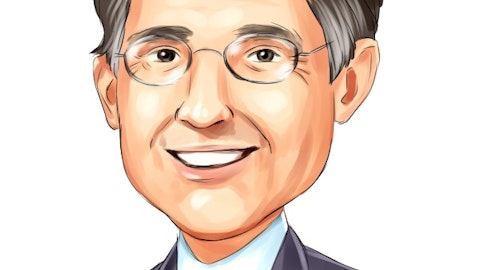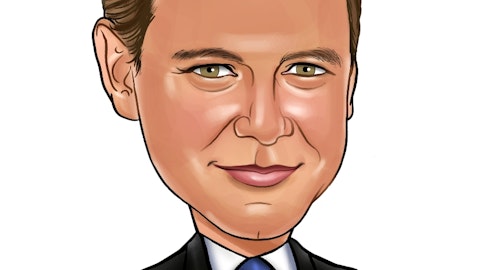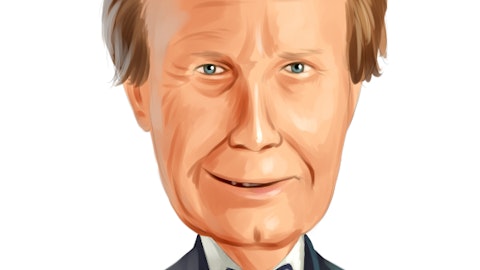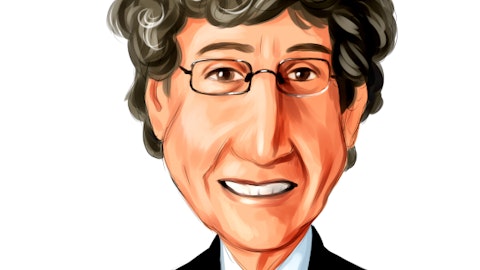Neuronetics, Inc. (NASDAQ:STIM) Q4 2022 Earnings Call Transcript March 7, 2023
Operator: Good day and welcome to the Neuronetics Fourth Quarter and Full-Year 2022 Conference Call. At this time, all participants are in listen-only mode. After the speakers’ presentation, there will be a question-and-answer session. Instructions will be given at that time. As a reminder, this call is being recorded. I would like to hand the conference over to Mark Klausner. You may begin.
Mark Klausner: Good morning and thank you for joining us for the Neuronetics fourth quarter and full-year 2022 conference call. Joining me on today’s call are Neuronetics President and Chief Executive Officer, Keith Sullivan; and Chief Financial Officer, Steve Furlong. Before we begin, I would like to caution listeners that certain information discussed by management during this conference call will include forward-looking statements covered under the safe harbor provisions of the Private Securities Litigation Reform Act of 1995, including statements related to our business, strategy, financial and revenue guidance, the impact of COVID-19 and other operational issues and metrics. Actual results can differ materially from those stated or implied by these forward-looking statements due to risks and uncertainties associated with the company’s business.
For a discussion of risks and uncertainties associated with Neuronetics business, I encourage you to review the company’s filings with the Securities and Exchange Commission, including the company’s annual report on Form 10-K, which will be filed later today. The company disclaims any obligation to update any forward-looking statements made during the course of this call, except as required by law. During the call, we’ll also discuss certain information on a non-GAAP basis, including EBITDA. Management believes that non-GAAP financial information taken in conjunction with U.S. GAAP financial measures provide useful information for both management and investors by excluding certain non-cash and other expenses that are not indicative of trends in our operating results.
Management uses non-GAAP financial measures to compare our performance relative to forecast and strategic plans to benchmark our performance externally against competitors and for certain compensation decisions. Reconciliations between U.S. GAAP and non-GAAP results are presented in the tables accompanying our press release, which can be viewed on our website. With that, it’s my pleasure to turn the call over to Neuronetics’ President and Chief Executive Officer, Keith Sullivan.
Keith Sullivan: Thank you, Mark. Good morning and thank you for joining us. I’ll begin by providing an overview of our recent performance followed by an operational update. Steve will then review our financial results and I’ll conclude with some thoughts on 2023 before turning to Q&A. We are pleased with our performance throughout 2022, a year which included several record quarters and the achievements of key milestones. We shipped over 210 systems to customers, bringing total systems shipped all time to over 2,000. In addition, our efforts to drive increased treatment session utilization has continued to pay off. As of the end of the year, the number of all-time treatment sessions surpassed $5.3 million. Across roughly 145,000 patients.
This all contributed to the total revenue growth of 18% for 2022. Proof that the investments made over the past two years in marketing, practice development, and patient education initiatives are working. I’m very proud of everything that we have accomplished in 2022, which we capped off by a strong fourth quarter. And I’d like to thank our employees, who delivered this high level of success by way of their hard work throughout the year. For the fourth quarter, total revenue was $18.2 million, up 21% over the fourth quarter of 2021. The strong performance was primarily driven by record treatment session revenue, as well as continued capital equipment sales growth. As we’ve seen our programs and initiatives take root. NeuroStar system revenue was $4.6 million, up 64% over the fourth quarter of 2021.
The success is due to the ongoing hard work of our strong team of area sales managers. Who found their group in nurturing and converting a robust pipeline, which was strengthened by yet another sold out NeuroStar Summit. The U.S. treatment session revenue was an all-time record of $12.5 million, up 11% over the fourth quarter of 2021. This record revenue was the result of positive growth at the local per click sites and was accomplished, despite slower than anticipated growth at our largest service provider as they work their way through merger integration. Our complete success was driven by our investments in 5 Star’s training program. The expansion of our PHQ-10 tool into more offices and greater availability of practice management training.
Now turning to our operational highlights. Our first focus area is increasing customer and patient awareness. We once again had a completely sold out NeuroStar Summit in Chicago, attended by 50 participants from 38 different practices. This event received outstanding feedback, which led to the conversion of several high-quality customers and the growth of our pipeline. The NeuroStar Summit have proven to be the number one event for educating and partnering with new TMS practices. Our area sales managers have done an excellent job helping these potential customers see the benefits NeuroStar can bring to them and their patients. The implementation of our proprietary PHQ-10 digital assessment tool, which allows our NeuroStar practices to easily identify patients within their practice, who are candidates for and have expressed interest in a NeuroStar treatment has been extremely fruitful.
We collected 98,000 PHQ-10s in 2022. And we will continue to enhance this tool to include new features within TrackStar to better manage and identify patients, who are candidates for NeuroStar treatment. Our NeuroStar University in Charlotte, North Carolina continues to receive excellent reviews from our customers. By year-end, we had hosted eight full capacity classes with attendees representing 75 accounts. And we now have a lengthy waiting list as we continue to evolve the capabilities of the platform, as well as the support services that we offer our customers, these classes will continue to be highly beneficial for both the new and existing users as we seek to leverage the power of NeuroStar to help more patients suffer incremental disorders.
We have begun to see positive benefits linked directly to the NSU training classes, such as the increase of 23% in treatment session utilization and an increase in PHQ-10 utilization from these NSU attendees. Our second focus area is the continued optimization of our commercial organization. In the quarter, we started to see some benefits from the efficiencies gained from our newly implemented salesforce reporting tools, which help our PDMs better understand our customers, their patient base and utilization trends. These tools allow the PDMs to help our account set goals and measure their progress towards achieving them. In particular, allowing accounts to more efficiently and more effectively identify and treat people in need. From within their own existing patient base.
As planned, we hired four additional PDMs earlier this year, due to the new account growth over the course of 2022. These additions will support the growth of our installed base and ensure we provide our customers with the highest level of service and support. Our third area of focus is leveraging exclusive commercial partnerships. We recently announced an expanded commercial partnership with Greenbrook TMS, which runs through year-end 2028. Under the agreement, we will be the exclusive supplier of TMS equipment to Greenbrook. With all other TMS devices being replaced with NeuroStars as their existing leases expire. This expand partnership will deliver several important synergies, including co-branding and co-marketing opportunities; enhanced patient and clinical awareness; improved patient access to care; and a collaboration on product development and publication.

Photo by Sasun Bughdaryan on Unsplash
Importantly, this agreement converts the entire Greenbrook organization, including Success GMS to our consumable pricing model and away from a fixed price one. We will offer our full spectrum of support and programs to Greenbrook centers and practitioners. In particular, we will offer tailored NSU classes and integrate our PHQ-10s and TrackStar to help Greenbrook reach and treat patients more effectively. With the help of this agreement, Neuronetics and Greenbrook will be able to make NeuroStar Advanced Therapy for Mental Health accessible to a growing number of people, who are struggling with mental illness. While we are enthusiastic about the long-term partnership with Greenbrook, and our ability to help them drive increased patient volume in their centers.
I did want to highlight that we have continued to see disruption resulting from the merger of Greenbrook and Success and the subsequent integration of the two businesses. As Steve will mention later, when he provides our guidance, we expect some revenue headwinds in 2023 as they continue to work through combining their companies. Lastly, I want to provide an update with our clinical and regulatory progress. In January, we announced a peer reviewed publication, which shows NeuroStar TMS as an effective non-drug treatment for depression with comorbid anxiety. Significant anxiety symptoms are present in the vast majority of depressed individuals and the majority of patients with anxiety disorders also have associated depression. We were able to study actual results and establish the effectiveness of this crucial therapy option for patients with anxious depression.
Thanks to the strength of TrakStar and the largest clinical data set for TMS in depression. Now for a quick update on the expanded medicare coverage. In February, NGS updated their healthcare policy, allowing nurse practitioners and physician assistants, who are within their scope of practice to order and provide TMS treatments to their patients with major depressive disorder. This is a welcome change as we have always recognized the importance of psychiatric nurse practitioners in delivering mental health care. This is especially true now given the shortage of healthcare professionals. In addition, United Health Care recently announced a positive coverage change, which expands access to NeuroStar therapy. Optum, the behavioral health benefit manager for United, reduced the number of prior medication failures for TMS eligibility from four down to two and remove the requirement for a trial of evidence-based psychotherapy.
As the largest healthcare insurer in the country covering 23.8 million lives United Health Care’s Optum’s decision to make NeuroStar more easily accessible and make a real difference in helping to alleviate the burden of drug resistant depression. To continue to provide greater access to NeuroStar therapy, we recently expanded our reimbursement team. This larger team will be able to increase our advocacy efforts related to favorable health policies and provide our customers with best-in-class reimbursement and billing support. In closing, I’d like to express my gratitude to our team for their dedication and perseverance in navigating the challenges of the current operating environment with ease. This hard work has enabled us to successfully execute on all initiatives during the year and bring relief to patients suffering from depression.
Looking ahead to 2023, we anticipate that the momentum we have built will continue to grow as we build on the solid foundation we have laid throughout 2022. With that, I’d like to turn the call over to Steve.
Steve Furlong: Thank you, Keith. Total revenue for the fourth quarter was $18.2 million, an increase of 21% over fourth quarter 2021 revenue of $15 million. U.S. NeuroStar Advanced Therapy System revenue was $4.6 million, compared to the prior year revenue of $2.8 million it was up 64%. The company shipped 58 systems in Q4, up from 48 systems shipped in the fourth quarter of 2021. U.S. Treatment session revenue was $12.5 million, an increase of 11% over fourth quarter 2021 revenue of $11.2 million. The revenue growth was primarily driven by an increase in utilization, in particular among our local per click customer segment. In the fourth quarter of 2022 revenue per active site was approximately $11,500, compared to approximately $12,200 in the prior year quarter.
Excluding Greenbrook and Success, revenue per active site was consistent year-over-year, despite having added approximately 100 new active sites during the year. Gross margins were 76% consistent with the fourth quarter of 2021. Operating expenses during the quarter were $21.5 million, an increase of $3.1 million, compared to the fourth quarter of 2021. The increase was primarily driven by our expanded sales force the opening of NSU, higher-than-expected sales commissions, incremental headcount and product development, investments in clinical, as well as increased costs from inflationary pressures. During the quarter, we incurred approximately $2.1 million of non-cash stock-based compensation expense. Net loss for the fourth quarter of 2022 was $8.3 million or $0.31 per share, as compared to a net loss of $7.6 million or $0.29 per share during the fourth quarter of 2021.
EBITDA for the fourth quarter of 2022 was negative $6.5 million, as compared to negative $6.3 million for the fourth quarter of 2021. As of December 31, 2022, cash and cash equivalents were $70.3 million. We continue to work with our lender SLR Capital Partners on an updated credit facility. We are on track to close on this new facility in March 2023. Now turning to guidance. For the full-year 2023, we expect revenue in the range of $66 million to $72 million. As Keith mentioned our guidance for 2023 assumes lower treatment session revenue from certain service providers, but continued strength from our local per click customers. For the first quarter of 2023, we expect revenue of $15 million to $16 million. We expect total operating expenses for the full-year 2023 to be in the range of $84 million to $88 million.
For the full-year, we expect cash utilization from operations to decrease year-over-year. Cash utilization will be the highest during the first quarter as it includes our national sales meeting, as well as prior year bonus payments; sales commissions and retention costs. Our operating plan continues to show that we will achieve cash flow breakeven with cash on hand. Our path to profitability is still on track, thanks to our projections for top line growth, solid gross margin profile and the careful management of our operating expenses. I would now like to turn the call back over to Keith.
Keith Sullivan: Thank you, Steve. 2022 was a critical year for Neuronetics as we continue to drive the accelerated adoption of NeuroStar. We have shown that the clinical results are superior. We have made significant investments in building the latest and most talented commercial team in the business. We have demonstrated unmatched ability to support our practices by assisting them with patient education and awareness campaigns to promote long-term success. To continue that success, we will focus on a number of key initiatives during 2023. One, increasing the number of customers, who participate in NeuroStar University. Two, working to incorporate a high percentage of customers into co-op marketing. Three, creating a network of accounts across the country that follow NeuroStar best practices.
Beginning with increased customer participation in NeuroStar University, as the initial cohort of customers has gone through training at NSU, we have clearly seen the immediate positive benefits at these accounts, including better PHQ-10 uptake and increased treatment session utilization. Because of this, we are working to increase the number of existing and prospective customers attending NSU classes, which provide important education to the providers to allow them to deliver better patient outcomes. The classes are crucial as we continue to develop NeuroStar capabilities and features such as our expansion into OCD, as well as the introduction of D-Tect and the MT Cap. Going forward, we are offering up to two classes per month throughout the year and incorporating attendance costs into our co-op marketing program.
Our second focus for 2023 is to incorporate a higher percentage of our customers into our co-op marketing program. There are over 60 customers, who are currently utilizing the benefits of our co-op marketing program on a regular basis. The co-op marketing program is one of a kind in the TMS industry. It provides us with an incremental opportunity to partner with our customers to help support their business and provide patients with access to care through increased awareness with co-branded, localized marketing campaigns. Customers who have participated in co-op marketing program have seen an average increase of four patients per quarter. We will continue to emphasize the expansion of customer participation throughout the year to bring the benefits of the program to more customers and their patients.
Turning to our third and final focus for 2023, creating a network of accounts across the country that follow NeuroStar best practices. Over the past few years, our company has made significant investment in the organization and the development of best practices for each customer to market effectively and drive long-term growth. We would like to take certain aspects of these proven practices to a broader network of our accounts. As we look ahead to 2023, we want to set certain standards across the accounts we serve, such as offering consistently high levels of service and increasing patient marketing within their offices. We expect to see these standards in customers, who fully utilize the uniqueness of the NeuroStar offering and our approach to the market.
We will continue to follow our plan in 2023. We have done tremendous work over the last two years to set ourselves up for success. And we have the strategy in place to drive the accelerated adoption of NeuroStar and bring relief to more patients suffering from mental health disorders. With that, I’d like to open the line for questions.
See also 20 Most Important Companies in the World and 10 Hot Growth Stocks to Buy Now.
Q&A Session
Follow Neuronetics Inc. (NASDAQ:STIM)
Follow Neuronetics Inc. (NASDAQ:STIM)
Operator: Our first question comes from Bill Plovanic with Canaccord. Your line is open.
Bill Plovanic: Hey, great. Thanks. Good morning. So obviously, I think the biggest question is on guidance and Greenbrook. One, what do you contemplate at the low-end and high-end in term — how does that reflected with Greenbrook, kind of, what percentage of your revenues are they today? And what do you expect out of that versus, kind of, the rest of your business? Thanks.
Steve Furlong: Hey, Bill, this is Steve. Obviously, with the press release yesterday, we did have to scramble and adjust guidance. At this point, all we know is they do anticipate closing 50 stores with a 10% impact on revenue, we don’t know the mix, we don’t know which stores are NeuroStar, we don’t know which percentage of revenue is Spravato versus TMS. And so, we took the approach really based on their contributions in 2022 versus our expectations in 2023 for growth. I think we’re in a wait and see mode at this point. So, you saw in our K — there — well, you haven’t seen an K yet, but you will, they’re a little bit north of 20% of our business. So, we believe the $66 million to $72 million range is appropriate at this time.
You can also see we did expand the range in revenue from our typical $4 million for the year to $6 million. Again, we just need to see how this plays out through the month of March and into the early part of Q2. Greenbrook announces the end of March and maybe there’ll be some more clarity into their plans and how it impacts us.
Bill Plovanic: Steve asked another way, what do you expect out of your core business in 2023? You’ve historically, if I look back, you grew 18% in 2022 – 12% in €˜21 and not even to go out of the growth as we exited 2022 was out of the non-Greenbrook businesses. So, given that’s 80% of your business, kind of, what was the contemplation of growth out of that core business as you think about 2023? Thanks.
Steve Furlong: Yes. I think it will be consistent with what we saw in the second-half of 2022, so in that 20% range. Again, if you look at our Q4 number 21% over prior year, that was negatively impacted by Greenbrook and Success’s performance. So, the per click consumable segment and some of the other segments are performing quite well. So again, I think it will be in that 20% range.
Bill Plovanic: And then last on this guidance question and then I’ll jump back in. It’s just how do we think about, kind of, the capital versus disposable especially getting our hands around like the assumptions probably given they’re shutting down 50 centers they can move capital around how do we think about capital in 2023 versus disposable? Thanks for taking my questions.
Steve Furlong: Sure, Bill. Yes, capital is going to be consistent with 2022, so we’ve communicated between 45 and 50 systems a year. We did slightly more than that last year and we anticipate that consistent level in 2023. So, there won’t be an impact from the Greenbrook integration efforts. We also expect international revenues to be flat, so all of the growth in €˜23 will be related to treatment sessions.
Bill Plovanic: You mean 45 to 50 systems a quarter, not for the full-year, correct?
Steve Furlong: Yes, quarter, yes.
Bill Plovanic: Thanks.
Operator: Thank you. Our next question comes from Adam Maeder with Piper Sandler. Your line is open.




